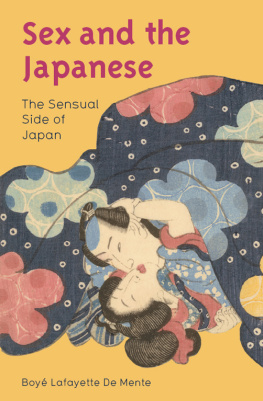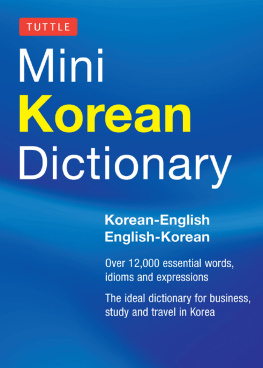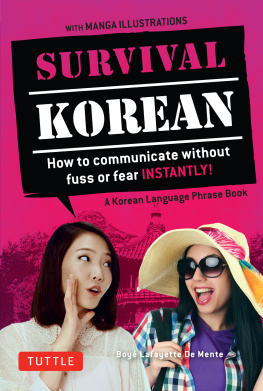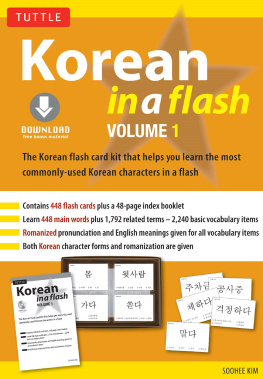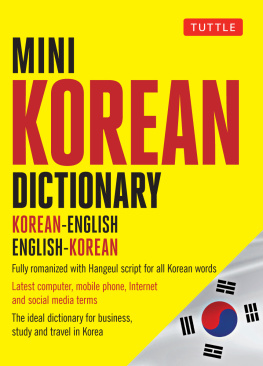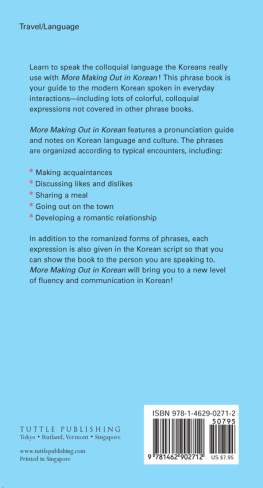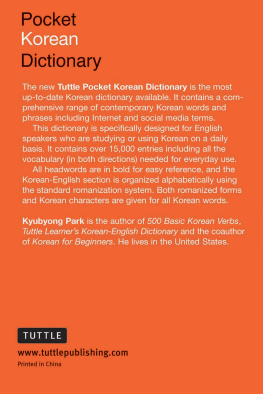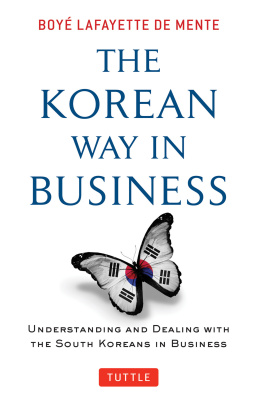THE KOREAN MIND
UNDERSTANDING CONTEMPORARY KOREAN CULTURE
BOY LAFAYETTE DE MENTE
REVISED BY LAURAKINGDON

ABOUT TUTTLE
Books to Span the East and West
Our core mission at Tuttle Publishing is to create books which bring people together one page at a time. Tuttle was founded in 1832 in the small New England town of Rutland, Vermont (USA). Our fundamental values remain as strong today as they were thento publish best-in-class books informing the English-speaking world about the countries and peoples of Asia. The world has become a smaller place today and Asias economic, cultural and political influence has expanded, yet the need for meaningful dialogue and information about this diverse region has never been greater. Since 1948, Tuttle has been a leader in publishing books on the cultures, arts, cuisines, languages and literatures of Asia. Our authors and photographers have won numerous awards and Tuttle has published thousands of books on subjects ranging from martial arts to paper crafts. We welcome you to explore the wealth of information available on Asia at www.tuttlepublishing.com.
Published by Tuttle Publishing, an imprint of Periplus Editions (HK) Ltd.
www.tuttlepublishing.com
Copyright 2017 Boy Lafayette De Mente
All rights reserved.
Library of Congress Cataloging-in-Publication Data
De Mente, Boye.
The Korean mind: understanding contemporary Korean culture / Boye Lafayette De Mente.
Includes bibliographical references (p. 462-466).
Summary: Koreans have a unique character and personality that sets them apart from all other Asians. And although Korean attitudes and behavior may be influenced by the modern world, the Korean mindset is still very much shaped by ancient culture and traditions. In The Korean Mind, Boye Lafayette De Mente explores the meanings and cultural context of the most important code words of the Korean language, terms whose significance goes well beyond their literal definitions. The reader is given insights into the character and personality of the Korean people, providing bridges for communicating and interacting with them.--Publishers description.
ISBN 978-0-8048-4271-6 (pbk.) ISBN 978-1-4629-2015-0 (ebook)
1. Korea--Civilization. 2. Korean language--Terms and phrases. I. Title.
DS904.D425 2012
951.9--dc23
2011031330
(Previously published under ISBN 978-0-8048-4271-6; ISBN 978-14-629-0770-0 ebook)
This Revised Edition ISBN 978-0-8048-4815-2
Distributed by
North America, Latin America & Europe
Tuttle Publishing
364 Innovation Drive
North Clarendon,
VT 05759-9436 U.S.A.
Tel: 1 (802) 773-8930
Fax: 1 (802) 773-6993
www.tuttlepublishing.com
Japan
Tuttle Publishing
Yaekari Building, 3rd Floor
5-4-12 Osaki Shinagawa-ku
Tokyo 141 0032
Tel: (81) 3 5437-0171
Fax: (81) 3 5437-0755
www.tuttle.co.jp
Asia Pacific
Berkeley Books Pte. Ltd.
61 Tai Seng Avenue #02-12
Singapore 534167
Tel: (65) 6280-1330
Fax: (65) 6280-6290
www.periplus.com
20 19 18 17 10 9 8 7 6 5 4 3 2 1 1709HX
Printed in China
TUTTLE PUBLISHING is a registered trademark of Tuttle Publishing, a division of Periplus Editions (HK) Ltd.
This book is dedicated to my wife, Margaret Warren De Mente, who made it all possible.
Acknowledgments
I am deeply grateful to Dr. Martin H. Sours, an authority on Korea and formerly professor of international studies at the American Graduate School of International Management (now Thunderbird School of Global Management) in Glendale, Arizona, for editing the final draft of this book, in the process of which he significantly improved the content of many of the entries and added to the clarity of others. I am also indebted to the following persons for reading the manuscript when it was in first draft and generously sharing their experiences and knowledge of Korea.
John H. Koo, Ph.D.
Professor of Korean, Center for Asian Studies, Arizona State University
Heon Jin Chang
President, Semco International, Seoul
Ernest Gerald Beck
Taekwondo Master, Orlando, Florida
Don Hackney
Korean Trade Specialist, Seoul
Hawk Sohn
Business Consultant, Seoul
Sokbom Han, Ph.D.
Arizona State University
Hosoon Ku, Ph.D.
Arizona State University
Understanding and Interacting with Koreans
Koreans share many cultural characteristics with the Chinese and Japanese because of their geographic proximity, long history of contact, and the mutual influence of animism, shamanism, Buddhism, Confucianism, and Taoism. China was, in fact, the primary wellspring of Korean civilization from around 108 B.C. until modern times. But the Korean people have retained a unique character and personality that sets them apart from the Chinese and Japanese as well as other Asiansa difference that derives from their deepest spiritual and philosophical beliefs and from an image of themselves that has been shaped by both internal and external factors over the centuries.
A significant part of the Korean character was obviously forged by the rugged mountainous terrain of the country and by a climate that runs to the extremes of hot and cold. Another part of the character of Koreans was wrought in the bloody crucible of ongoing battles with raiders and invaders from the north and from the sea. Whatever the individual factors that went into the makeup of the Korean character and personalityand there were many othersthe end result was a formidable people who have yet to achieve the full promise of their potential and from whom the world will hear a great deal more.
Contemporary Korean scholars and observers, including Dr. Jae Un Kim, a developmental psychologist and the author of several books on the Korean mind-set and behavior, have noted a variety of surface changes in the attitudes and behavior of Koreans since the end of the nineteenth century, but they say that the national character of Koreans has remained essentially the same.
As is the case with all ancient cultures created within highly refined and meticulously structured social systems over thousands of years, one of the keys to understanding traditional Korean attitudes and behavior is the language of the peopleor, more precisely, key words in the language. These key words provide access to the Korean mindto core concepts and emotions, the attitudes and feelings that make up the Korean psyche. These key terms reveal both the heart and soul of Koreans and provide bridges for communicating and interacting with Koreans on the most fundamental level.
I have selected more than two hundred of the most culture-laden words in the Korean language and attempted to explain their special role in history and in Korean life today in a way that is both meaningful and useful.
Boy Lafayette De Mente
A Note on Korean Names
Approximately half of all Koreans share only five family names, and distinguishing among them is a genuine challenge. The roman letters used to represent Korean sounds may also vary with the geographic region and with individuals, resulting in the same names often being spelled differently. Brothers and sisters in a family also usually share a second given name that distinguishes their generation and is known as their generational name.
Generational names usually come after the personal or first nameand therefore appear like middle names to Westernersbut some people may put them first when writing their names in English, further complicating matters. Some names are written with the first name and the generational names separate and with the initial letters capitalized. Others connect the two names with a hyphen, sometimes with the initial letter of the generational name capitalized and other times with it in lower case. Some people run the two names together as if they were one. The same editions of English-language newspapers and magazines published in Korea and abroad often present Korean names in two or three different ways.
Next page

